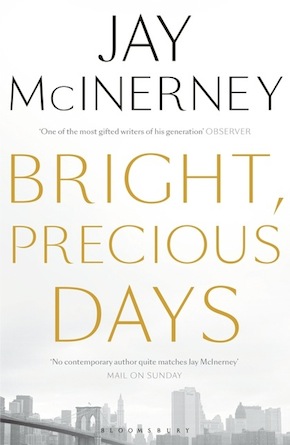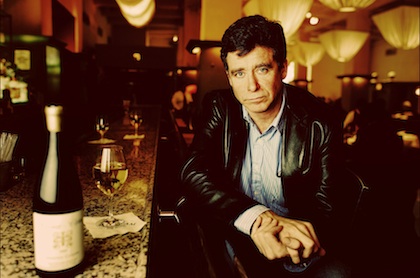Boom or bust
by Brett Marie
“A scabrously scintillating stylist.” Guardian
A hundred pages into Jay McInerney’s new novel Bright, Precious Days, Russell Calloway treats himself and a co-worker to lunch. As the editor-in-chief of a small New York publishing house, Russell has just initiated a pre-emptive bid on a hot prospect: the harrowing memoir of a journalist who recently escaped from a Taliban prison cell. It’s 2007, and with the housing bubble ballooning and his business sputtering, Russell needs a big payoff to keep his family’s semi-comfortable Lower Manhattan lifestyle afloat. The stakes for this acquisition are high, but he has reason to believe he’s got the inside track, and following the stress of the bidding, the phone calls to the journalist’s agent and the publisher’s backer, he finds some relief in the restaurant’s atmosphere: “The rooftop restaurant had just reopened for the season, and it seemed almost miraculous to dine outside, with the sun on your face, looking out over the Hudson, the slightest fetid whiff of which reached him on the breeze.”
Within that one sentence lies everything that’s right – and wrong – with Bright, Precious Days, the third and presumably last instalment in the saga of Russell Calloway and his wife Corinne. For McInerney fans, I’m sure the phrase’s artful prose, a tiny love note to all of the contradictory joys of New York life, is an indication that the author hasn’t lost his chops. And for those of us who have followed the Calloways from their beginnings in 1992’s Brightness Falls, it’s a comfort to think that there are still exciting times ahead for our fictional friends. I’m happy to report that McInerney’s return to well-trod ground is largely worthwhile, that the new iterations of the familiar Calloway dramas (Will Russell’s latest gamble keep his Max Perkins fantasy going? Will Corinne be able to keep her rekindled affair with the private-equity exec Luke McGavock a secret?) play more like variations on a theme than outright retreads. At the same time, the author works in enough backstory from Brightness Falls and its sequel The Good Life to keep new or forgetful readers up to speed and make the novel work as a standalone.
Long before the stocks take their inevitable dive, it’s New York’s inexorable gentrification that poses the most sinister threat.”
Russell’s time-out on a Manhattan rooftop restaurant feels like a suitably luxuriant interlude. It is the shortest of many; the Calloways are go-getters, but they’re known to pause for a dinner party or a Hamptons vacation when the opportunity arises. As the date inches toward the looming 2008 stock market crash, the Calloways are already caught up in a different financial crisis. Twenty years after settling in the former industrial district of TriBeCa, they watch their cramped, rented loft, which they now share with their pre-teen twins, become prime real estate. Tension grows when their landlord signals that their building will be turned into condominiums; Russell dreams that they might wangle a down payment on the exorbitant asking price, while Corinne tries to convince him that moving to the outer boroughs or even New Jersey wouldn’t be the end of the world. Long before the stocks take their inevitable dive, it’s New York’s inexorable gentrification that poses the most sinister threat.
Taken at face value, it’s a decent premise, and fired from McInerney’s pen, it hits home. Russell takes risks because he sees the home he created for himself, in the community he helped to found, floating out of his reach on an incoming tide of ridiculous wealth. The stakes are heightened because of the injustice of it all: a group of idealistic young people (Russell and Corinne call it the Art and Love team) burrow into a wasteland of abandoned factories and commercial buildings, turning a web of steel and concrete into a network of lofts and art studios – only to be squeezed out when their efforts turn the neighbourhood into a fashionable area and their cost of living surges beyond their meagre budgets in the ensuing property boom.
But here is where the novel trips up. When Russell splurges on a gourmet lunch, when Corinne makes a donation of several thousand dollars to her once and future lover’s charity in some sort of relationship foreplay, their freewheeling extravagance takes a tear or two out of their sob-story.
I mentioned the book and its premise to the novelist Ernesto Quiñonez, whose Bodega Dreams tells a story that might as well take place on another planet rather than ten miles uptown from Russell and Corinne. “Wow,” he replied, “so Jay’s new book is about the glamorous Calloways not being able to afford their apartment in Manhattan. I got an idea: maybe the Calloways can marry into the Hearst fortune like their author. Case solved.” Perhaps it’s hitting below the belt to make a dig at McInerney’s marriage to the granddaughter of one of America’s most opulent tycoons. But Quiñonez’ comment does add a bit of perspective. His follow-up softened the blow a little: “Unlike the poor and immigrants being priced out of NYC the Calloways have a high education and access to friends in high places who could help them jump-start their careers if things go south. Your average poor don’t.”
Watching the Power and Money team horn in on their turf, it’s easy enough to sympathise with Russell and Corinne. But viewing things from their vantage point ignores an uncomfortable truth: in the gentrification game, Art, Love, Power and Money all wear the same jersey. The Calloways were pioneers in a wasteland abandoned by industry, but more often elsewhere, as in Harlem and Brooklyn’s Bedford-Stuyvesant neighbourhood, settlers like them start the process of supplanting the real underdogs: I’ll call them the Blood and Sweat team. Mostly minorities, generally less educated, often the children of immigrants or immigrants themselves, these are your tired, your poor, your huddled masses still yearning – and often working their asses off – to breathe free. It’s these folks who populate the East Harlem of Bodega Dreams, an environment much closer to the ground than Russell’s rooftop restaurant – if the breeze off the nearby East River carries in anything fetid, the Blood and Sweat team will catch more than a faint whiff. These days, following a New York Times article last February that included East Harlem in a list of ‘New York’s Next Hot Neighbourhoods’, it seems like only a matter of time before Art and Love make their move. Where does that leave those poorer residents, once their rents or property taxes outstrip their income? Where do they go?
Perhaps McInerney is afraid of the PC blowback if he mishandles the feelings or actions of a minority character. But we pay a price for his tactful omission.”
I’ve read a lot of opinion pieces lately about the lack of diversity in literature. Reading Bright, Precious Days, I think I see the light. As a narrator, McInerney can tell a story from any point of view he chooses. As an author, however, he is a prisoner of his own circumstances. Of course he can attempt to portray characters whose backgrounds differ from his own, but any such portrayal would require a certain amount of research, a bit of role-playing, and more than a little daring. But oh, how little he dares. Other than Russell’s best friend Washington, who after an early verbal assertion of his blackness at a dinner party settles into the stereotypical role of oversexed philanderer (a role admittedly shared by more than one white co-star), African Americans show up mostly to get food from Corinne’s charity organisation or to show our heroes to their tables. Hispanic men get to be drug dealers in an eighties flashback; twenty years on, their wives and daughters have been promoted to nannies.
Perhaps McInerney is afraid of the PC blowback if he mishandles the feelings or actions of a minority character. But we pay a price for his tactful omission. Early in the novel, Corinne is seen directing a food handout in the Bronx. At a loss when their food runs out unexpectedly, she tries to give cash to a mother standing in line with two children, only to be viciously shouted down by the offended mother. I found myself wanting to understand the root of this stranger’s defiant pride, to explore the values that would lead her to accept a handout of food but scoff at money (which she ends up taking anyway). But such cultural lessons are outside the scope of Bright, Precious Days, and McInerney is more interested in exploring Corinne’s embarrassment in front of her suitor Luke.
Much later, after vast sums of money evaporate in the blast of the 2008 crash, Corinne laments to Luke that her charity’s funding is drying up, in language that treats hungry people like a line in a profit and loss statement. The dialogue is literally small-talk, but it triggers that same sense of a missed opportunity. How are those hungry people holding up? Where are they these days? Again, I couldn’t tell you.
Don’t get me wrong, I love a good high-society novel. McInerney has my blessing to write from the ivory tower; his characters shine, and they’ve got a hell of a view. But I already had a rough idea, going in, of where the Calloways would land when the 2008 crash shook them off of their faux-riche tightrope. Perhaps they’d get knocked a rung or two down the status ladder, but more likely their trajectory would be sideways. My songwriting hero Chuck Berry wrote in his autobiography about the rags-to-riches lyrics to his signature tune, ‘Johnny B. Goode’: “It is obvious that a story that brings a subject from out of the boondocks to fame and fortune is more dramatic than one out of midtown to somewhere crosstown.” The same rule applies going the other way.
Bright, Precious Days is a solid story by a talented writer; I doubt that many lovers of the Calloways will be disappointed. But I can’t take the Sunday Telegraph seriously when it calls the author one of “a small number of dissident novelists… who change the way we look at American history.” The view doesn’t change much if you’re always looking from the same angle. What do things look like from closer to the ground? I couldn’t tell you. But as a reader, I’m now determined to find someone who can.
 Jay McInerney is the author of seven novels, two short-story collections and two non-fiction books on wine. He writes a wine column for the Wall Street Journal and is a regular contributor to the Guardian, the New York Times Book Review and Corriere della Sera. He lives in Manhattan and Bridgehampton, New York. Bright, Precious Days is published by Bloomsbury in hardback and eBook.
Jay McInerney is the author of seven novels, two short-story collections and two non-fiction books on wine. He writes a wine column for the Wall Street Journal and is a regular contributor to the Guardian, the New York Times Book Review and Corriere della Sera. He lives in Manhattan and Bridgehampton, New York. Bright, Precious Days is published by Bloomsbury in hardback and eBook.
Read more.
jaymcinerney.com
@JayMcInerney
Author portrait © David Howells
Brett Marie, also known as Mat Treiber, grew up in Montreal with an American father and a British mother and currently lives in Herefordshire. His short stories such as ‘Sex Education’, ‘The Squeegee Man’ and ‘Black Dress’ and other works have appeared in publications including The New Plains Review, The Impressment Gang and Bookanista, where he is a contributing editor. He recently completed his first novel The Upsetter Blog.
Facebook: Brett Marie
@brettmarie1979

